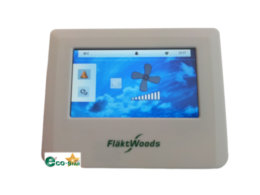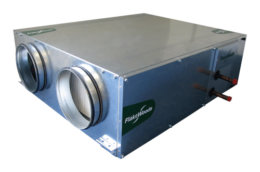Based on standard delivery, ex. VAT
Heat Recovery Systems
Why use a heat recovery system?
“Nearly half of the UK’s co2 emissions come from buildings. And half of heating/cooling cost is caused by ventilation when it is done by the “open window” method according to the regulations”.
Correctly selecting ventilation recovery units in a building can be the most cost-efficient, sustainable and quickest way to reduce a buildings energy consumption. An added benefit is this also can provide better indoor air quality (IAQ) and protect buildings from (Sick Building Syndrome SBS).
Not sure if it applies to my circumstances?
The ‘air tightness’ of building is increasingly being targeted to improve building efficiencies and reduce energy bills, meaning (in most cases) for newer buildings, there is a greater the need for ventilation by heat recovery, helping to reduce running costs. Building owners and occupiers can save more money over a period of time.

In which Industrial/Commercial buildings should I use Heat Recovery?
Heat recovery can potentially be applied to any HVAC system that uses ductwork to supply and extract ventilation air. You can commonly find opportunities in:
- schools
- offices
- lecture theatres
- hospital wards
- swimming pool halls
- manufacturing areas
It’s worth noting that installations in new buildings where mechanical ventilation is being provided are almost certain to contain some form of heat recovery. This is because current building regulations demand a level of efficiency which is very difficult to achieve without it and such techniques are now commonly adopted.
There are so many options on the market, what’s the minimum I should include in my Heat Recovery Unit?
100% Bypass — To get the most from your Heat Recovery Unit 100% Bypass is a must have, when used in conjunction with the minimum controls below, your Heat Recovery Unit will give you the most optimum efficiency. 100% Bypass prevents you from recovering heat during the summer months when you want to get rid of heat within the building. Bypass also gives you an option to have free cooling in summer* with a controlled balance of fresh air and recirculated heat
Re-Heat Devices (the two most common type of heating devices are Electric and LPHW (water) coils) — Re Heat is another must. Re Heat will add extra heat to the recovered air when needed, no Heat Recovery Unit can be 100% efficient no matter what you read, meaning the recovered heat will never reach the temperature of the ambient air in the building, why is this a problem? As a quick example when the outside air temperature is ‑4C and the inside ambient is 22C the recovered heat air temperature will be approx. (depending on RH levels) 11C after the heat exchanger if this air is not then reheated (topped up) you could end up reducing the overall building temperature and increasing the load on the main heat source. If this air is reheated to 22C no overall temperature is reduced and no additional requirement is put on the main heating source.
Controls — to control the incoming, return and supply air a number of temperature sensors are required to be mounted within the unit. To enable full optimization of these temperature sensors fully integrated controls will be required to realize the full potential of your Heat Recovery Unit.

Temperature Sensor (preferably a duct sensor) — To get the most from your Heat Recovery Unit, this sensor is used to ensure the unit is balanced to supply air at the optimum required temperature within the room, we would suggest this will change between summer conditions and winter conditions, just like your central heating thermostat at home. In winter you want to ensure the return air is warm enough not to feel a cold draught. In summer you want to ensure you make the most of free cooling to make those long summer days and nights as comfortable as possible*
Passive Infrared Sensor — used to detect occupancy
CO2 Sensor — Have you ever felt tired in class in the afternoon, one of the main reasons is a high level of CO2, and poor indoor air quality (IQA), and this sensor will increase the ventilation rate on demand. Thus keeping co2 levels at a normal level which will increase productivity in the work place.
Humidity Sensor — Modern buildings are becoming air tight which seals off the movement of moisture, this has resulted in a secondary problem of condensation forming in and around walls, which encourages the development of mold and mildew. Good ventilation can be used to remove this stale, moist air and replace it with clean fresh air.
I need more convincing Heat Recovery is the right choice for me?
Energy Recovery Comparisons based on an independent study based on one Heat Recovery Unit (Supply and Extract)
Energy Consumption (kWh)
- 10,267 kWh None Heat Recovery
- 3,011 kWh with Heat Recovery
Carbon Usage / Saving (Tons)
- 5.3 tons of co2 None Heat Recovery
- 1.8 tons of co2 with Heat Recovery
Running Costs / Savings (UK Pounds), Based on a correctly sized Flakt Woods ECO STAR Heat Recovery Unit
- £1602 None Heat Recovery
- £470 with Heat Recovery
Payback
2.7 years based on a correctly sized Flakt Woods ECO STAR Heat Recovery Unit
* Free cooling is when the external air temperature is below the internal ambient air temperature and the internal ambient air temperature is higher than the temperature sensor setting. In this instance the heat exchanger will be in 100% bypass and full fresh air will be delivered via the supply system and help to reduce the internal ambient air temperature thus giving free cooling
Example — External air temperature 20C, internal ambient air temperature 30C, temperature sensor setting 24C, free cooling will occur
